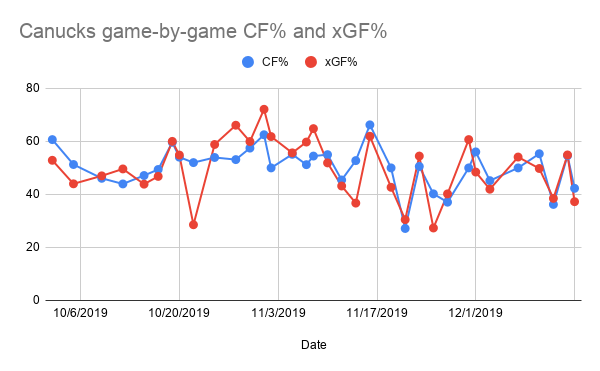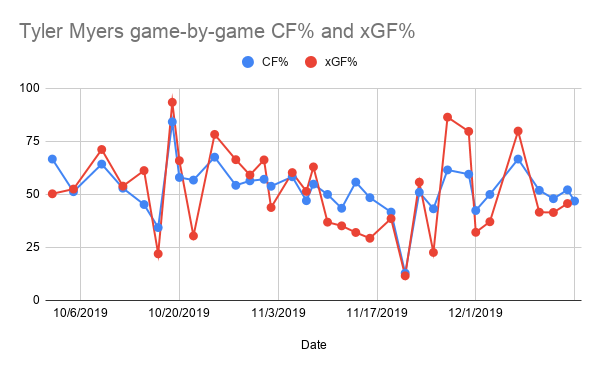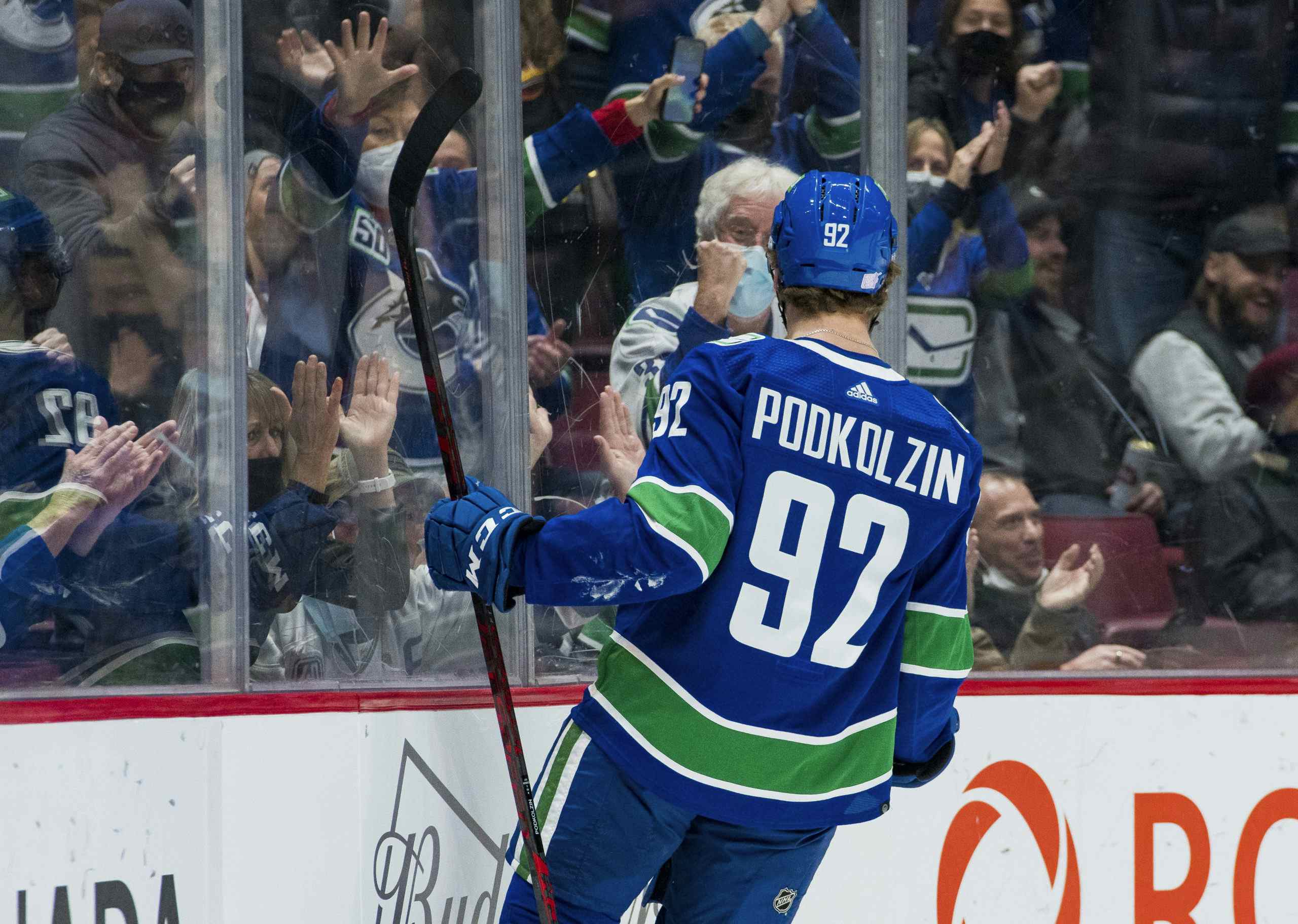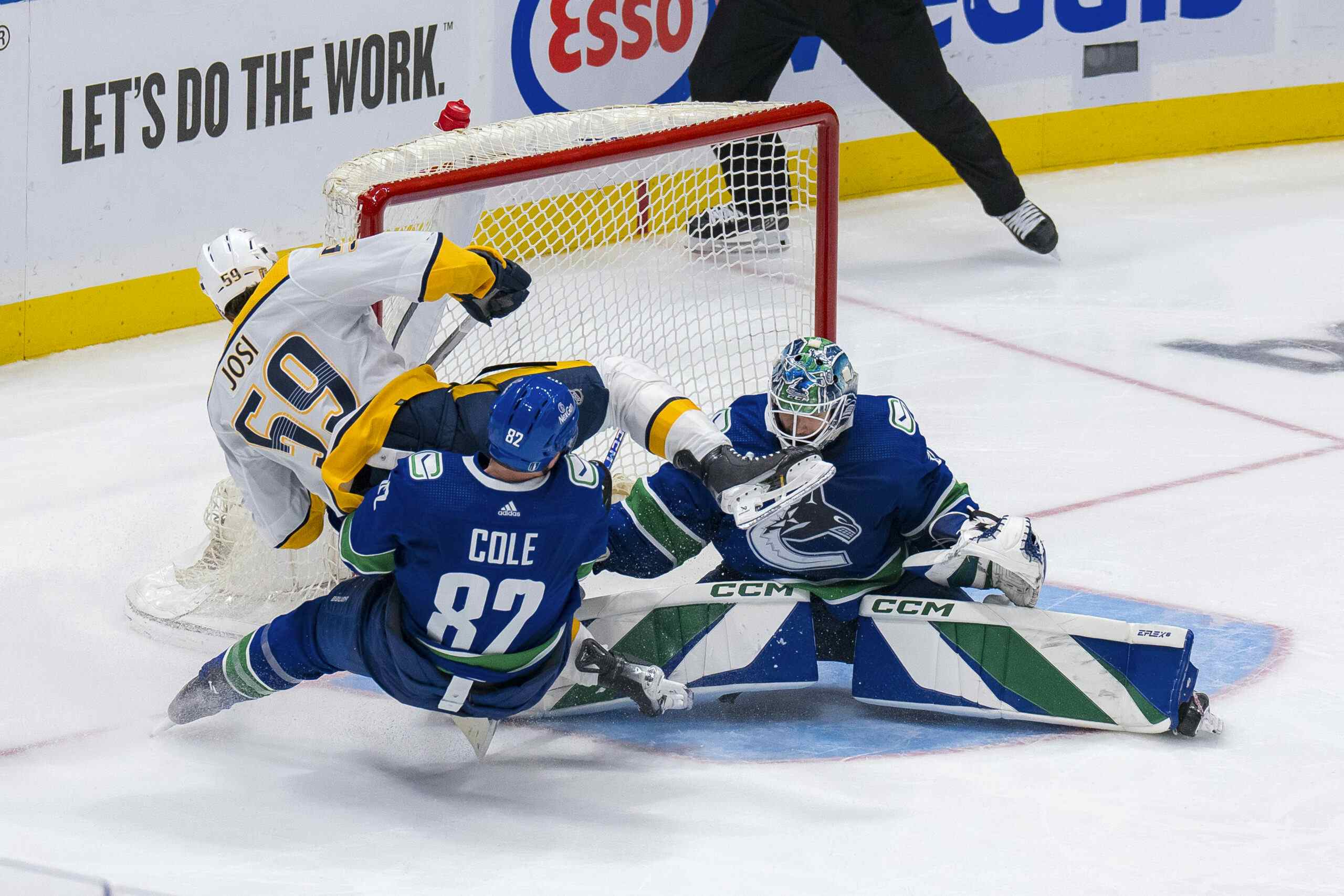The Canucks May Be Worse Than Their Underlying Numbers Suggest

4 years ago
It’s only been two weeks, and mediocre is starting to look like a compliment.
The Canucks have now lost three of their last four games, and have scored just seven goals over that span. They’ve now dropped to 3-4 in the month of December, with five of their six remaining games against playoff teams.
And yet, they still boast reasonable strong underlying numbers. They’re currently in the black by both shot and expected goal-share, if only slightly, and rank 13th overall in the league in each category.
This was perhaps the most common criticism I received of my “mediocre” article: the Canucks boast slightly above-average numbers by shot and expected goal share, and a power play that’s performed at well above average. It’s also the main crux of the argument in what I would say has been the best rebuttal to what I wrote, a piece Thomas Drance published in the Athletic titled “The Canucks are a playoff-calibre team“. (It’s great, go read it.)
My intention isn’t to put Thom on blast, but rather to use his piece as a jumping-off point for some of my own observations. He’s quick to point out that the line between “mediocre” and “playoff-calibre” is thin as dental floss, and I think he makes fair assessments about how the team has performed at evens, on both special teams, and how their goaltending has held up.
Throughout my discussions with those who disagreed with my initial article, one stumbling block for my assertion that the team is due to fall away from the pack has been their relatively strong underlying numbers. However, as the team has hit the skids over the past six weeks or so, I noticed some trends that I think may reveal some holes in our analysis.
First off, I should note that the majority of Drance’s assertions are correct, and need no further explanation or context. Chief among them is that the lotto line has been one of the best in hockey this season, even as their even-strength production has taken a dip. The Miller-Pettersson-Boeser combo appears to be completely legit, in spite of the fact that the team as a whole has completely cratered since early November.
Outside of the first line (and the stellar play of Quinn Hughes), however, I’m not sure we should be drawing any firm conclusions about the team’s underlying profile, even if they’ve hit a significant point in the season from a sample size perspective.
Drance mentions that Vancouver is the NHL’s only team whose top two centres are in the black by CF%. While that’s true in an absolute sense, I think it’s worth noting that it hasn’t been the case for the past six weeks or so– in fact, the Canucks have been trending heavily in the wrong direction since November 10.
If October was a vindication of all the work the team has put in to building around the team’s young core, the team’s performance against stronger competition since then has been nothing short of a stunning rebuke.

From the start of the season up until November 10th, the Canucks were rocking an impressive 53.6 CF% and a 54.5 xGF%. Since then, they’ve averaged a much less impressive 48.48% and 44.62%, respectively. It’s a massive drop in overall team performance, and one that’s worth exploring more deeply.
There are a few explanations for why the Canucks have fared so poorly as of late in comparison to how they played throughout October. The first is dumb luck, which really can’t be discounted. The Canucks’ top performers have struggled at even-strength for long stretches this year, and while that may be performance or systems-related to some extent, poor puck luck has also undeniably played a major role.
Another possibility is depth and injury issues. Losing Jay Beagle, Brandon Sutter, and Alex Edler for stretches has certainly cost them, but how much the team deserves to be cut some slack for their performance in light of those injuries is up for debate. At some point, the front office can’t use injuries to players like Sutter and Edler as an excuse for poor performance anymore. Injuries to those players aren’t a bug, they’re a feature, and they have to be accounted for at the roster construction stage. Injuries are also just a part of the reality of day-to-day life in the NHL, and good teams find a way to power through them. While players being sent to the infirmary has certainly played a factor in the team’s decline, it would be disingenuous to use them as an excuse for poor performance, especially when the team’s core group of young and talented players has remained intact.
A third possibility is that, to borrow a phrase from Dennis Green, the Canucks Are Who We Thought They Were, and we let them off the hook.
When you look at how bleak things have been for the team since they cooled off in early November, it’s hard not to wonder if the increase in the quality of their opponents combined with teams keying in on their new additions have conspired to make them a less formidable opponent than they were at the start of the year.
Perhaps no player has been hit harder by the increase in quality of competition than Tyler Myers, whose decline has been even more pronounced than that of the team as a whole.

Myers’ decline from where he was at just a little over a month ago serves as a proof-of-concept for that third possibility. Before November 10th, Myers was an elite defender by expected goals, boasting an xGF of 58.2%, and looked comfortable in his role as the team’s top right-handed defender. Since then, his performance has cratered, he’s averaged an xGF of just 44.6%, and has been outplayed by each of the Canucks other two right-handed defenders from an underlying perspective. At this point, it’s probably worth questioning whether or not it was a smart idea to assume Myers’ first 15 games as a Canuck were more indicative of who he is as a player than the previous 600 or so that he logged with the Buffalo Sabres and the Winnipeg Jets.
When I boldly declared the Canucks to be mediocre just two weeks ago, it was based on a fairly simple observation: the Canucks had essentially been two different teams. They were excellent in October, and below average in November, and logic dictated that their true nature lied somewhere in the middle.
The only problem was, I failed to adequately articulate a disturbing fact for a team that went all-in to make the playoffs with the moves they made this offseason: the Canucks are trending in the wrong direction, and it remains to be seen if they can stop the bleeding.
While the team boasts some relatively impressive underlying numbers at first glance, the reality is that they’re still being propped up by an unusually strong October. Their numbers over the first six weeks of the season stand in stark contrast to their numbers over the last six weeks, and they’ve now been genuinely bad for roughly the same amount of time that they were genuinely good.
Perhaps it’s just recency bias talking, but at this point, it’s worth considering the possibility that the Canucks recent downward spiral isn’t a blip, but a trend; and if the team continues on this pace through the end of December and into January, it might be time to accept that 2019-20 is going to be yet another example of the Canucks getting off to a hot start in October and fizzling our over the remaining five months of the season.





